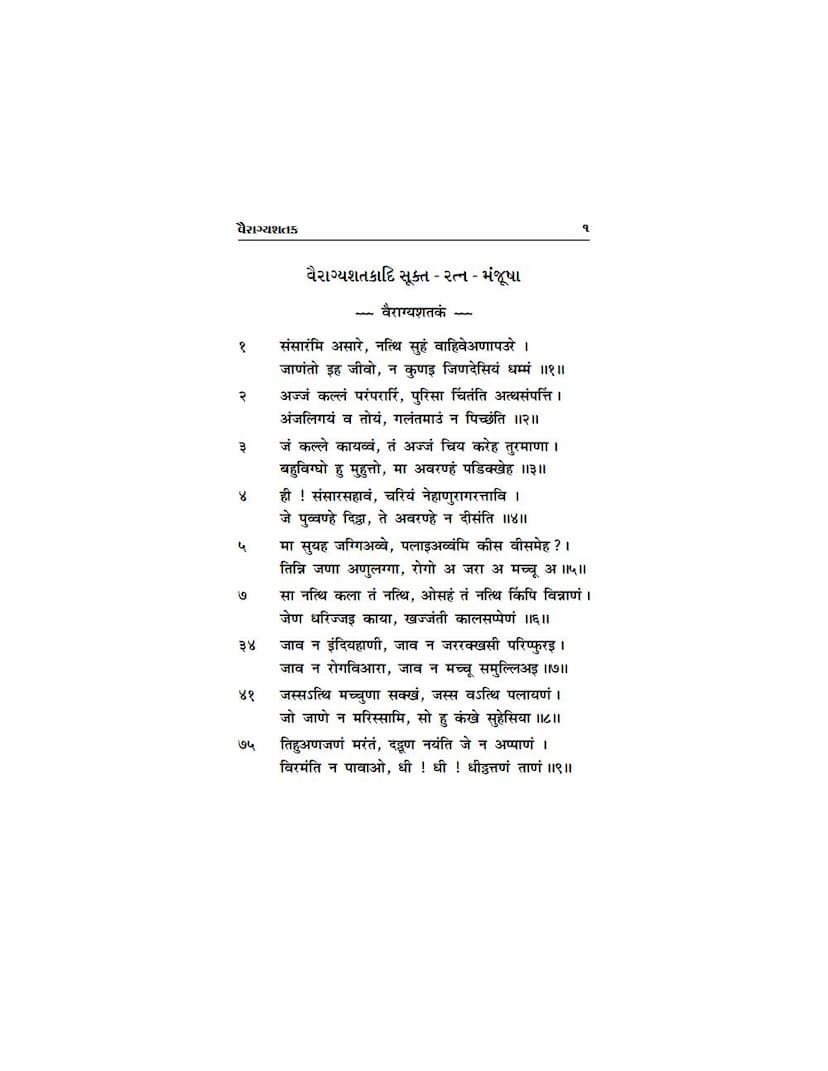Sukta Ratna Manjusha Part 11 Vairagyashatakadi
Added to library: September 2, 2025

Summary
Here's a comprehensive summary of the provided Jain text, "Sukta Ratna Manjusha Part 11 Vairagyashatakadi" by Bhavyasundarvijay, based on the Gujarati text:
Overall Theme: Renunciation (Vairagya) and Spiritual Discipline
The text is a collection of devotional and philosophical verses primarily focused on the Jain principles of renunciation, detachment from worldly pleasures, understanding the transient nature of existence, and the importance of righteous conduct and spiritual practice. It emphasizes the suffering inherent in the cycle of birth and death (samsara) and guides the reader towards liberation (moksha) through the teachings of the Jinas.
Key Concepts and Themes:
-
The Illusory Nature of the World (Samsara):
- The verses repeatedly highlight that the world (samsara) is temporary and filled with suffering. Life itself is compared to a drop of water on a blade of grass, precarious and fleeting.
- Possessions, youth, beauty, relationships, and worldly joys are all described as impermanent, like lightning, dreams, or bubbles in water.
- The text warns against being deluded by these transient pleasures, urging the reader to seek the eternal and the true.
-
The Inevitability of Old Age, Sickness, and Death:
- The verses paint a stark picture of aging, disease, and death as relentless forces that cannot be overcome by any worldly power or knowledge.
- The inevitability of death is a recurring theme, serving as a catalyst for renunciation. The text questions why individuals continue to cling to worldly pursuits when these three forces are ever-present.
-
The Importance of Righteousness and Spiritual Practice:
- The core message is the adherence to Dharma as taught by the Jinas. This Dharma is presented as the only true refuge and the path to ultimate happiness.
- The verses advocate for mindful action, doing what needs to be done today rather than procrastinating, as time is fleeting and moments are precious.
- The text stresses the importance of good conduct, controlling the senses, understanding the self, and cultivating detachment.
-
The Suffering in Different Realms of Existence:
- The text graphically describes the intense suffering experienced in various realms of existence, including hells (naraka) and the animal realm (tiriyanch).
- It details the torment, hunger, thirst, and various forms of pain endured in these lower births, emphasizing that these are the result of past negative karma.
-
The Rarity and Value of Human Birth:
- Human birth is considered exceptionally rare and precious, a unique opportunity to attain spiritual liberation.
- The verses lament those who waste this precious human life on trivial pursuits, failing to embrace the teachings of the Jinas. Such individuals are criticized as unfortunate and unwise.
-
The Power of Karma:
- The concept of karma is implicitly and explicitly present, explaining the suffering experienced in different births and the consequences of actions.
- The verses indicate that individuals reap the fruits of their own actions, whether good or bad.
-
The Path to Liberation:
- The path to liberation is presented as the practice of Dharma, which involves controlling the senses, cultivating knowledge, practicing austerity, and maintaining equanimity.
- The text identifies virtues like wisdom, detachment, compassion, and right conduct as essential for spiritual progress.
- The verses encourage introspection, self-awareness, and the understanding of one's true self, separate from the body and the world.
-
The Collective Nature of Spiritual Pursuit:
- While individual effort is crucial, the text also implies that the path of righteousness is a shared journey, and good conduct is admired and practiced by wise people.
- The verses highlight that Dharma is the only companion that does not abandon one in times of need.
-
Controlling the Senses (Indriya):
- A significant portion of the text is dedicated to the subjugation of the senses, which are described as unruly horses that drag the soul towards suffering.
- The verses provide metaphors and warnings about the destructive power of uncontrolled desires and sensory attachments, equating them to thieves that steal spiritual wealth.
-
The Teachings of the Jinas:
- The verses consistently refer to the teachings of the Jinas (victors over passions) as the ultimate guide to truth, happiness, and liberation.
- The Jain Dharma is presented as a divine gift, a wish-fulfilling tree that grants the fruits of heavenly and liberation-bound happiness.
Specific Sections/Themes Highlighted:
- Vairagya Shatak (Hundred Verses on Renunciation): This section forms the core, emphasizing detachment from worldly pleasures and the transient nature of life.
- Indriya Parajaya Shatak (Hundred Verses on Conquering the Senses): This part focuses specifically on the mastery over the senses, describing their deceptive allure and the suffering they cause when uncontrolled.
- Upadesha Ratna Mala Kulakam (Garland of Jewel-like Teachings): This section offers practical advice and ethical guidelines for living a virtuous life.
- Gautam Rishikritam Gautam Kulakam: This section, attributed to Sage Gautam, delves into wisdom, conduct, and the consequences of various attitudes and actions.
- Upadesha Mala Sookta Ratna Manjusha: Further teachings and guidance are provided in this section.
In essence, the "Sukta Ratna Manjusha Part 11 Vairagyashatakadi" is a profound compilation of Jain wisdom, urging readers to awaken from the slumber of worldly attachment and embrace a life of spiritual discipline, renunciation, and devotion to the Jain path for ultimate peace and liberation.